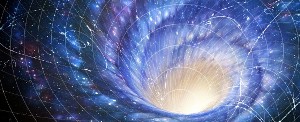Sep 5 2013
For three weeks in August, leading physicists from all over the world attended the Mass 2013 conference at CP³-Origins in Odense, Denmark. Lots of new calculations were presented, among them the results of the project ‘Dark Matter from a Composite Goldstone Boson’ – a lattice study of SU(2) gauge theory with two fundamental fermions.

The project is a collaboration between CP³-Origins’ Francesco Sannino, Claudio Pica and Ari Hietanen, working together with Randy Lewis from York University, Toronto, who presented the results.
- One of the longstanding interests for people here at CP³ has been to find a deeper understanding of the Higgs boson, Randy Lewis says. That is a huge issue for physics. Another huge issue for physics is what dark matter actually is. We are excited about this calculation because it seems to give a possible answer to both, at the same time.
On July 4, 2012 at a packed press conference in Geneva, scientists at CERN announced that they had found the elusive Higgs boson, the particle credited with giving all other particles mass. Physicists had been in pursuit of the Higgs for close to 50 years, and with the help of CERN’s Large Hadron Collider, they were able to finally find near-conclusive evidence of its existence in their data.
On the basis of the Higgs-discovery, the physicists from CP³-Origins along with Randy Lewis explored the basic mass spectrum and published their results in 2012. The team’s new calculations are considering the scattering cross section for the dark matter candidate, Randy Lewis explains:
- In a very simple way, the theory we have of protons and neutrons is called the strong interaction. It is an SU(3)-theory. This theory is even smaller and simpler – an SU(2)-theory. And yet, it has a dark matter candidate, and simultaneously does all the job of giving masses to W’s and Z’s that the Higgs boson is meant to do in the standard model.
Looking for the Higgs in the new theory
The calculations have been two years underway. But there is still a lot of work to be done.
The new theory has to do the job that the standard model Higgs sector is supposed to do – that is giving mass to all the known particles, but the researchers also require the model to simultaneously explain dark matter. Another important point is that not only do the researcher need to reproduce the Higgs “sector” of the standard model, but also the Higgs-like particle. This particle can emerge naturally but its observed mass depends on the way the theory couples to the standard model and its dynamics. The supercomputer simulations to elucidate this important point are extremely expensive but underway.
- My personal suspicion, says Randy Lewis, is that if we look in this theory as we have defined it now, we will find that there is a Higgs-like particle, and it will probably be heavier than 125 GeV. We will then have to ask ourselves what ingredient is missing that, if added, will make the mass slide down to 125 GeV.
CP³-Origins moves science forward
The results are only one example of new research that was presented during Mass 2013. In Randy Lewis’ opinion, CP³-Origins does not only do a good job at getting people together. With conferences like this, the centre also takes science to the next level.
- I think this kind of discussion among physicists that we have experienced at Mass 2013 is really important for science to move forward. It is not enough for me to sit in Toronto, send emails to Odense, write a paper, publish it in an American journal and let all these other people read it. Science will blast forward when places like CP³-Origins hosts people and get them all in the same room and let us fight it out, learn from each other and get inspired. That is to the credit of places like CP³-Origins who is the catalyst that makes people get together. It is worth the effort and expense and travel to make science go better and faster than it otherwise would have, Randy Lewis says before rushing home to Canada to work on the next step of the calculations.